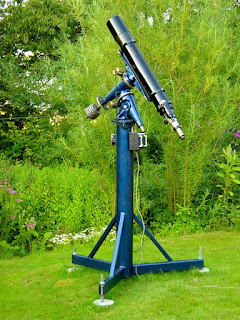*
WARNING: SOLAR OBSERVATION REQUIRES GREAT CARE AND SAFE FILTRATION.INSTANT PERMANENT BLINDNESS CAN EASILY RESULT FROM SIMPLE MISTAKES.
NEVER LOOK AT THE SUN THROUGH ANY LENS, MIRROR OR INSTRUMENT UNLESS IT HAS BEEN FULLY TESTED AND APPROVED FOR SUCH USE. YOU FOLLOW MY EXAMPLE ENTIRELY AT YOUR OWN PERIL!
Three weeks into January and not much ATM accomplished so far.
 After waiting for 50 years I am rather keen to get into [low budget] Hydrogen-alpha solar viewing [and hopefully a bit of imaging.] My timing is highly imperfect with the Sun descending into its quiescent phase of its 11 year cycle. There is even talk of a spotless Sun enduring. Not to mention all the cloud in the Earth's own atmosphere.
After waiting for 50 years I am rather keen to get into [low budget] Hydrogen-alpha solar viewing [and hopefully a bit of imaging.] My timing is highly imperfect with the Sun descending into its quiescent phase of its 11 year cycle. There is even talk of a spotless Sun enduring. Not to mention all the cloud in the Earth's own atmosphere.My [wishful] thinking is that my raised observatory will provide much better seeing so far above the ground. Daytime viewing also keeps me out of mischief and at home. All without conflicting with an Evening's Netflix TV streaming.
I made my own spectroscopes literally from scratch back in my youth. Including making a pair of 60mm achromats and a high density, 60° flint prism. Closely spaced razor blades acted as slits and I could see literally thousands of lines in the brilliant [and occasionally blinding] Solar Spectrum.
Any plans for a mechanical spectrohelioscope at that time were dashed by a lack of a suitable grating. I spent ages researching at the reference library on how to make one. There was no internet back then and most books were long out of date.
Nowadays all I need for H-α viewing of surface detail and prominences is is a used [but not abused] Coronado PST with still undamaged, internal components. This will be used as a donor for modifying my old 6" f/8 Celestron to H-α. I don't really need the PST objective except for quick looks at the Sun to check for interesting activity.
I'd hate to spend serious money on an old and secondhand PST with a rusty ITF [blocking] filter. The new prices for the PST have doubled while I wasn't paying attention. With 10-year-old PSTs now listed at new, retail prices of only a few short years ago.
It would cost around £100 extra for a new replacement ITF [blocking filter] bought from the US. That's with import taxes, postal customs clearance charges, freight charges and 25% Danish VAT on top of everything, including the US retail price.
Then there's the cost of the 90mm Baader D-ERF [for heat rejection purposes] to go inside the big refractor. There's no real need for a full aperture filter to go in front of the objective. Being monochromatic in nature, H-alpha ignores the usual achromatic aberration of a 'fast' f/8 achromatic doublet. It will be automatically stopped down to 125mm by the small PST etalon. 1200/125 is much closer to the f/10 of the PST.
Here's a YouTube video showing typical images seen through a PST and the effects of software stacking to achieve very sharp, still images in Hydrogen-alpha light. Note the prominences and surface detail.
The H-α system relies on leading and trailing lenses sandwiching a special filter [the etalon] to pass parallel light through the filter. The focused light from the telescope objective is first made parallel with a negative lens at 200mm inside focus. Then refocused again with a matching positive lens after "conversion" [or very narrow band filtering] to H-alpha by the etalon in the middle of the group. H-α is a line in the visible, deep red of the Solar Spectrum.
This modification to a larger aperture refractor is well proven using the internal components of a donor PST. Providing excellent, high powered images at a small fraction of the cost of a dedicated H-alpha, commercial, solar telescope which run into the thousands of pounds/dollars retail for larger apertures. The PST is undamaged by the modification. So can be rebuilt to its original layout. A number of manufacturers offer special adapters for PST connection or even adding a star diagonal in place f the PST's internal prism.
My old, Fullerscopes MkIV equatorial mounting can easily cope with the 6" refractor on its massive, welded steel pier. I have used the combination regularly to take handheld "snaps" at the eyepiece without visible camera shake. I replaced the three, original 10" pneumatic, trailer nose wheels with solid, puncture-free wheels. These solved a number of problems of mobility and lack of damping in the original air filled tyres without compromising freedom of movement.
----------------------------------------------
[It's odd but none of the published Alt key Codes work for α [alpha] in W10. Alt+ 224 and Alt +945 are listed online but neither works. Not even with a zero in front. It seems the only way to insert alpha is to Copy and Paste. Hey-ho. Hey (slow) presto!]
*
